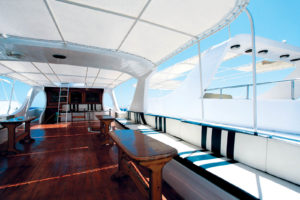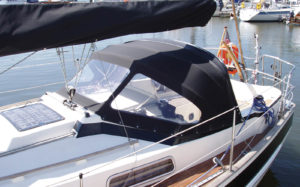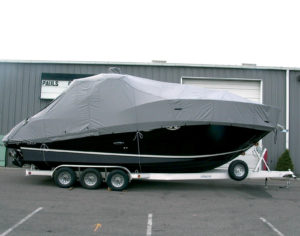Factors for choosing fabric
Fabricators know that successful marine products are made from many components. But, for their customers, the finished product is all about the fabric. Does it look good? Does it keep water out? Will it last? It’s up to the fabricator to select the best fabric for the project and the customer, based on the fabric’s characteristics and the customer’s specific situation and needs.
 The fabric may need to be waterproof and mildew-resistant. It may need to resist abrasion where it passes over windshield frames, and it may need to be strong enough not to rip around fasteners. It must maintain its appearance and durability through years of exposure to sunlight, temperature swings, varying humidity and many types of soil and dirt.
The fabric may need to be waterproof and mildew-resistant. It may need to resist abrasion where it passes over windshield frames, and it may need to be strong enough not to rip around fasteners. It must maintain its appearance and durability through years of exposure to sunlight, temperature swings, varying humidity and many types of soil and dirt.
All fabrics developed and manufactured for exterior marine applications have some subset of these desirable but often mutually exclusive characteristics. “If something is waterproof, it’s not likely to breathe, and if it breathes, it can be treated for water repellency but it’s not going to be waterproof,” says Tom Koster, marine products manager at Tri Vantage. A breathable fabric that works well as a mooring cover can suffer wear and tear if it’s used for trailering, subjected to the buffeting and abrading that happens when a covered boat is towed. Coated fabrics stand up better to abrasion, but may have little or no breathability. “All of these fabrics can be used for all these end purposes, but there’s a give and take on their performance,” Koster says.
The moisture barrier
Perhaps the greatest challenge facing fabricators is choosing the fabric that will keep the boat dry inside and out. The trade-off between allowing moisture to evaporate off boats and preventing rain from getting into boats is at the heart of many fabric selection decisions.
Since the pores of waterproof fabric are closed, any moisture that’s on the boat will not be able to evaporate, creating a friendly environment for mold and mildew. Waterproof fabrics are made from either nonwoven material, such as vinyl, or coated, woven fabrics, such as vinyl-coated polyester.

Woven polymer fabric is strong and fade resistant. Fabricator feedback reports the fabric is lightweight and easy to handle. Photo: Safety Components Fabric Technologies Inc.
Water-resistant fabric has very small pores that allow only a small amount of water to permeate it, yet moisture can evaporate through it. Reducing the fabric’s pore size, by using a tighter weave, for example, will increase the fabric’s water resistance. The degree of water resistance decreases as time goes by. Simply handling the cover eventually reduces water resistance, as will heavy winds, environmental factors, such as high humidity and intense sunlight, and normal care and maintenance. Any one factor may not have much effect, but several factors in combination will quickly diminish resistance. Many water-resistant fabrics can be retreated to restore resistance.
Water repellent fabric causes moisture to bead up and wick away. Water repellency diminishes over time from handling, cleaning and exposure to wind, humidity, sunlight and pollutants. If a fabric loses it’s repellency, water will not bead up on the surface. Instead, the drops flatten out, soak into the fabric and eventually leak onto the boat. There are treatments to restore water repellency to many fabrics.
Moisture present on a boat before the cover is put in place needs an evaporation route. “If moisture is on the underside surface of a boat cover, how fast it moves through the cover is a measure of the fabric’s breathability,” says John Pierce of Safety Components Fabric Technologies. Breathability is measured, according to the Textile U presentations from Marchem CFI’s website, by establishing how many grams of water vapor evaporate per square meter within a 24-hour period. The industry standard for breathable fabrics is 625. A fabric rated 625 and above doesn’t need to be vented; fabrics rated below 625 are still breathable, but need to be vented.
Strength and durability
Another important consideration for the fabricator is the fabric’s durability: its strength, its ability to withstand abrasion and how well it maintains its color and texture. Heavier fabrics are typically stronger and able to resist more force before tearing than lighter fabrics. Coated fabrics, since they have more than one layer, withstand rubbing and abrasion longer than non-coated fabrics. Solution-dyed fabrics typically keep their color longer and fade less than yarn-dyed fabrics over time.

Covers intended to remain in place while the boat is towed on a trailer must withstand abrasion and buffeting at wind speeds approaching hurricane force (74mph). Photo: Safety Components Fabric Technologies Inc.
Tear and tensile strength refer to the fabric’s ability to withstand force without tearing. Tear strength shows how much force is necessary to continue a tear that’s already started, such as the hole created when snaps are inserted into a cover. It’s measured in ppi (pounds per inch), and a higher tear strength rating means the fabric can withstand more force before ripping. Some manufacturers, such as MarChem CFI, perform trapezoidal tear tests. It starts with a tear, pulls at 90 degrees and measures how much force is required to make an additional tear, but running in a different direction from the original tear.
Tensile (or burst) strength refers to how much force it takes to tear a hole in fabric that has not been torn previously. Tensile strength test results are also reported in ppi, and a higher number indicates stronger fabric.
Abrasion resistance is the fabric’s ability to withstand rubbing and resist having a hole worn through it. Generally, coated fabrics and heavier fabrics tolerate abrasion better than lighter and uncoated fabrics, due to the additional material. Abrasion resistance is measured by how many cycles (rubs) are needed to wear a hole in the fabric, how much material is worn away after a specific number of cycles, and by counting “double-rubs,” a testing method that passes a pad back and forth over the fabric until it wears a hole in it. Each back and forth pass is a double-rub.
Dimensional stability is important to the long-term appearance and functionality of marine covers. Fabrics can stretch and shrink over time. Stretching increases the pore size of woven fabrics and lets water seep through. Fabric that has stretched can sag and allow water to pool, leading to leaks. Certain applications require the fabric to be dimensionally stable; others need it to stretch. The degree of stretch is tested by measuring a length of fabric, applying a specific amount of force for a specific period of time, then measuring it again. Shrinking is measured by applying heat under controlled circumstances and making similar comparative measurements. “When you fabricate vinyl, it does not stretch when you compare it with a woven fabric,” says Craig Zola, business manager, awning and marine fabrics, Herculite Products Inc. “So your measurements and your cut lines are pretty close. Over time, they’re not going to stretch either. Vinyls are a very stable option.”
Color and fading
Colorfast fabrics resist fading when exposed to environmental factors such as sunlight, humidity, atmospheric gases and cleaning products. Any one of these elements can cause fading, but the effect is accelerated when more than one is present. According to MarChem CFI’s Textile U, solution-dyed fabric retains color better than coated products. Solution-dyed means that the pigments are added to the “gel” that will become yarn during the production process.
The color in coated fabrics can rub off onto a boat’s gel coat or upholstery (called crocking). Crocking can occur whenever a coated fabric fits tightly over a stress point and rubs against the boat or upholstery.
Construction
The way yarn, which is woven to create fabric, is manufactured determines its strength. Yarns are either filament or staple. Filament is stronger than staple yarn, which is small pieces spun together. “Acrylic starts as a gel and turns into a very hard substance,” Pierce says. “If it’s rolled out it would be like uncooked spaghetti. So it’s chopped into tiny pieces to make it into a soft yarn. Polyester is processed at a high heat. It’s melted then extruded.”
Polyester and nylon are examples of filament yarn fabrics; acrylic is an example of staple yarn fabric. Generally, staple yarns have a better hand. They are softer and more pliable. But filament yarns can be texturized in order to get the same effect without losing strength.
“Every fiber has its benefits and has its drawbacks,” Pierce says. “Its point of failure could be abrasion, it could be tearing, it could be UV degradation, it could be fading, it could be other things. But each fiber or each type of product will behave differently in all those different areas.”
Laminating can provide a high-quality fabric at a lower price, provided it’s used in the right climate. Cold temperatures during northern winters negatively affect laminated fabrics. “Laminated fabrics are bigger in the South where it doesn’t freeze,” Koster says. “If you get below 30 degrees and you get a high wind, it’s destructive.” The layers of laminate can pull apart. Under the right circumstances, though, laminated fabrics deliver effective performance. The center layer, a mesh substrate, gives the laminate its strength and stability.
Nothing about fabric selection is straightforward. There is no simple one-to-one correspondence between an exterior marine project and a particular fabric. Each project presents a set of requirements that must be satisfied, yet many fabric characteristics are mutually exclusive: waterproof or breathable; soft and pliable or tough and dimensionally stable; laminated or coated. The final choice will depend on the end user’s needs.
Fabricators, after talking with their customer, rank these fabric characteristics and determine which ones are best suited to the client’s project. They use all of this information to arrive at the final fabric selection decision.
Mary Jo Morris previously owned and operated Berkeley Marine Canvas in Berkeley, Calif. She and her husband, Jim, live in Point Richmond, Calif., and sail on San Francisco Bay.
 TEXTILES.ORG
TEXTILES.ORG 






